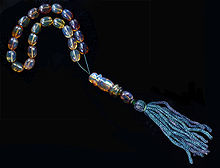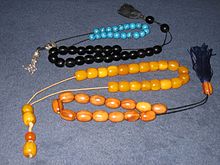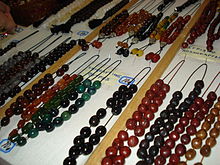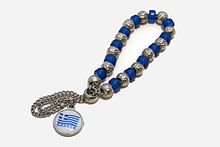- Kombolói
-
- Kombologion is also a subgenus of the gastropod mollusc genus Calliostoma
Kombolói or kompoloi (Greek: κομπολόι, IPA: [ko(m)boˈloj], bead collection; plural: κομπολόγια, IPA: [ko(m)boˈloʝa]) is a part of modern Greek and Cyprus culture, used to relieve stress, keep hands and fingers occupied and generally pass the time. It was especially popular up to the end of the 20th century while now it has dropped in popular use. However, it is still considered a symbol of Greek (and especially rembetiki) culture and a niche.
Contents
Etymology
Modern Greek κομπολόι is derived from medieval Greek κομβολόγιον < κόμβος "knot" + -λόγιο "collection". On a different take on the etymology, κομπολόι is short for the phrase σε κάθε κόμπο προσευχή λέω, "in every knot I say a prayer"- κόμπο "knot"-λέω "say" > κόμπο-λέω > κομπολόι.[1][2] This etymology accounts for the fact that κομπολόι evolved from κομποσκοίνι, the Greek word for prayer rope.
Purpose and origin
Komboloi worry beads resemble prayer beads, but, unlike them, do not necessarily bear religious significance. Some collectors enjoy them for religious devotions, and seek komboloi with 33 beads to represent the life of Christ. In modern times komboloi are also used by people who want to limit smoking.
The origin of the Greek komboloi is debated. It may derive from the komboskini used by Orthodox monks or the Islamic Misbaha. Armenians also have their own worry beads which serve the same purpose as the komboloi and are also non-religious in nature.
Features
 A rare komboloi made of Blue Amber.
A rare komboloi made of Blue Amber.
Komboloi are constructed from any type of bead, although amber, amber resin (such as faturan) and coral are preferred, as they are thought to be more pleasant to handle than non-organic materials such as metal or minerals.
Greek komboloi generally have an odd number of beads (usually one more than a multiple of four, e.g. (4x4)+1, (5x4)+1, and so on) and usually have a head composed of a fixed bead (παπάς "priest"), a shield (θυρεός) to separate the two threads and help the beads to flow freely, and a tassel (φούντα). Usually the length of a komboloi is approximately two palm widths.[3] A variation of the komboloi with an especially long string, often with only two beads, is known as begleri (μπεγλέρι).
Komboloi often have a prime number of beads on the string, usually 17, 19 or 23. Those with spacer beads, usually metal, between the coloured plastic or glass ones, still have a total number which is a prime number, e.g. 37.[citation needed]
Use
Komboloi can be handled in many different ways. The most common are a quiet method, for indoors, and a noisier method that is acceptable in public places. The most common quiet method is to start at one end of the thread or chain, near the shield, and to pull the thread forward using that hand's thumb and the side of the index finger until one of the beads is reached. Then the cord is tipped so that the bead falls and hits the shield. This is repeated until all the beads have been tipped and then the user starts over.
The second, louder, method is to divide the beads in to two groups. On one end is the shield and a small number of the beads. On the other end is the rest of the beads. Where the two threads are empty, that space is laid between the index and middle fingers. The hand should be in a position where the palm is facing the torso. Then the end behind the hand is swung up and forward so that it hits the other beads, making a noise. The threads are then switched back into the space between the index and middle fingers by holding the threads between the thumb and the side of the index finger. This is repeated rhythmically, creating a louder clicking noise than the quiet method. An easier and soothing method is to hold all of the kombolói in one hand and roll the beads against each other, creating soft clicking sounds.
A more modern version of these worry beads continues to gain increasing popularity. Sometimes called wigglers, these simple strings of beads can be used in a number of ways, including both one- and two-handed methods that involve rapidly wiggling the beads in various directions. Fans claim that wiggling the beads creates a rush of adrenaline, followed by a soothing, calm sensation.
See also
Culturally related articles:
Similar items in other cultures:
Notes
- ^ neolaia.de (Greek)
- ^ athensinfoguide.com (Greek)
- ^ Tasos Thomaidis, The Path of Man and Worry Beads, Tasos Thomaidis Publications, 2001. ISBN 960-87105-1-0
References
- Aris Evangelinos, The Komboloi and Its History, Komboloi Museum Publications, 1998.
Categories:- Beadwork
- Greek culture
Wikimedia Foundation. 2010.



